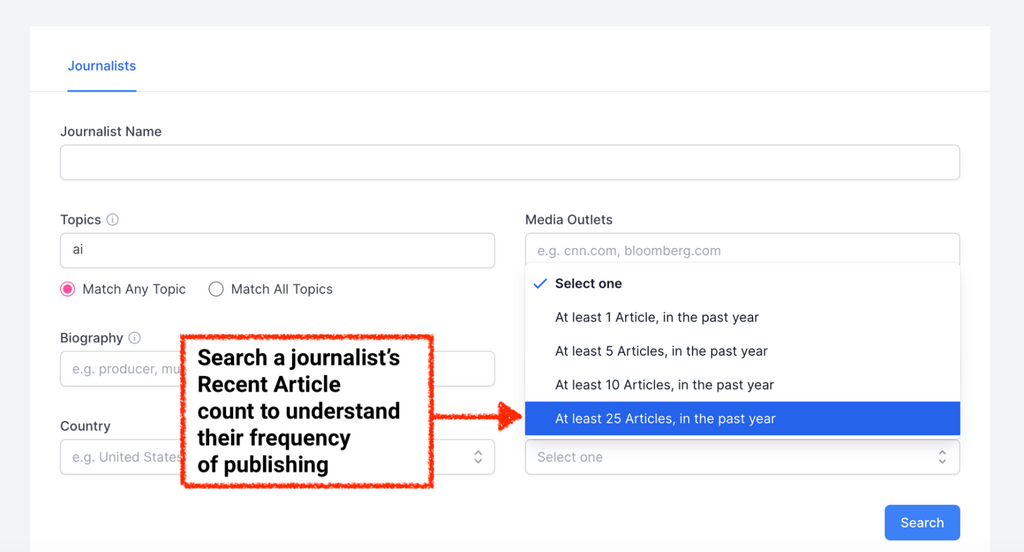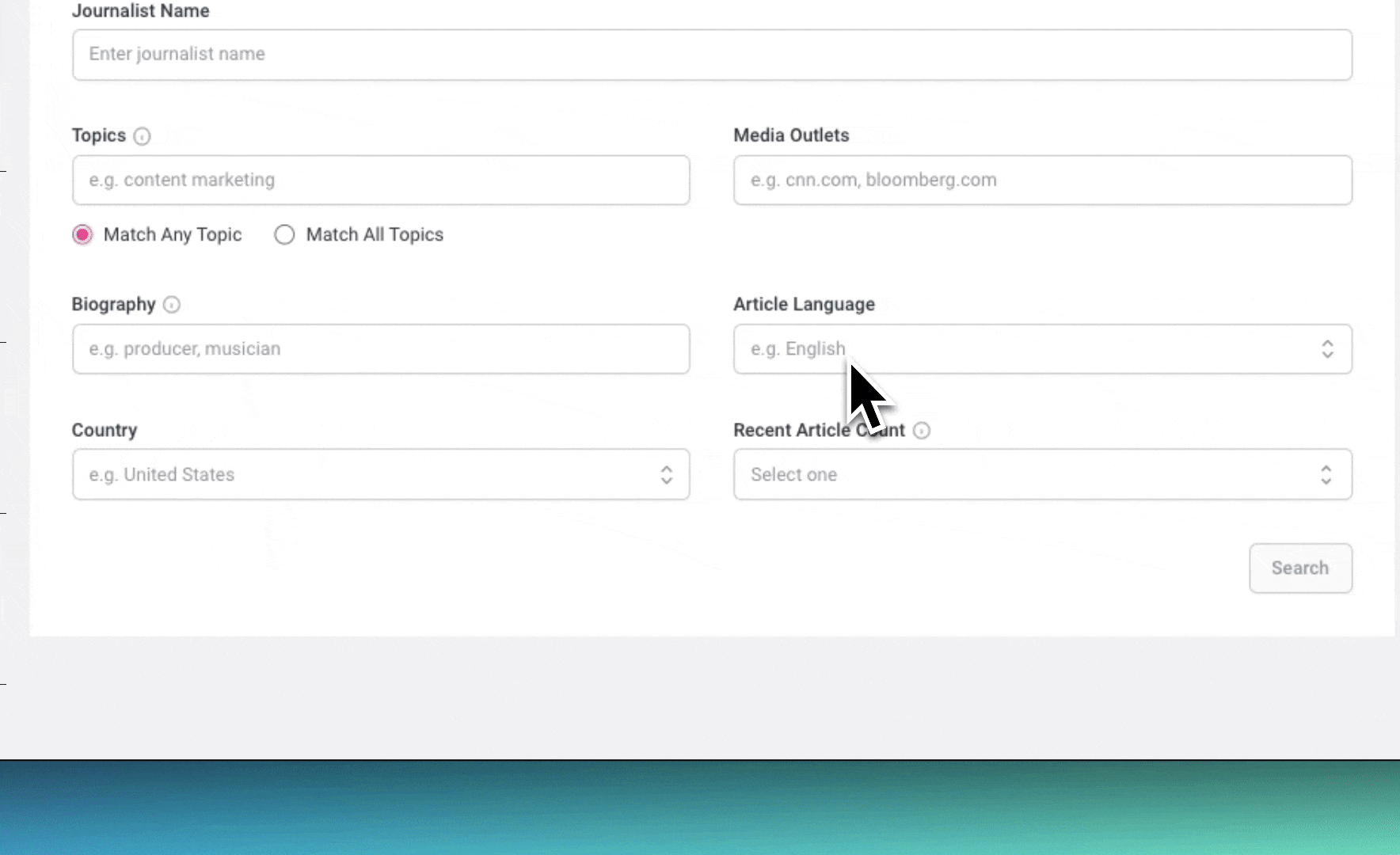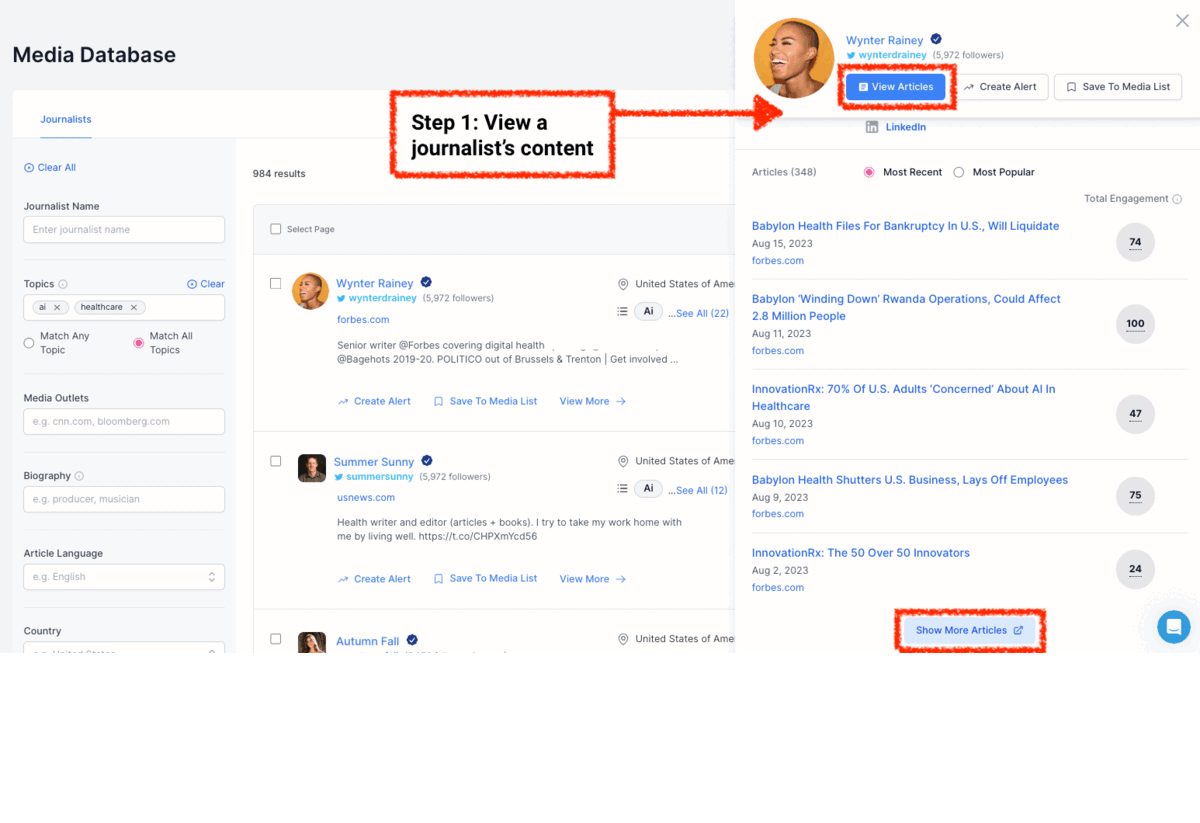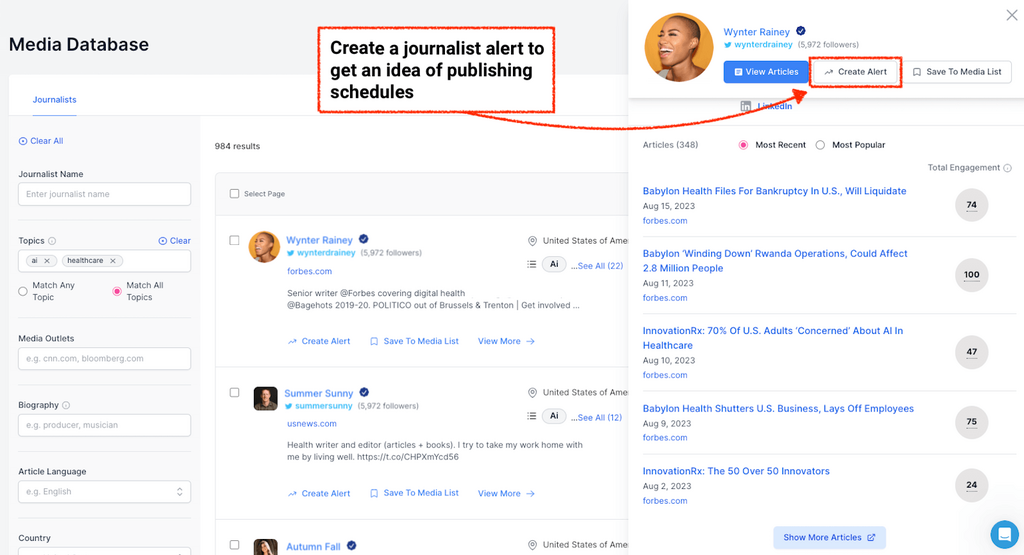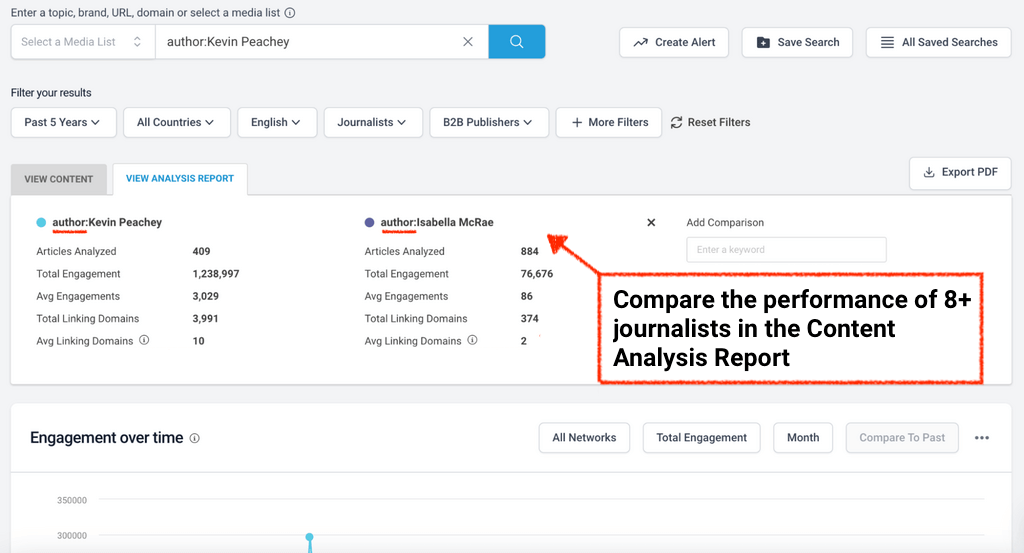I’m here to tell you that the key to winning media coverage is about becoming obsessed with one thing: journalist content.
Do I have an agenda?
As a savvy PR/marketer, you know that I do.
(ps. check out our Journalist Database that's just full of journalist content)
Good. Now we’ve got that out of the way, let me tell you why you should drink my kool aid.
Over the last year we’ve sat down with a great many PR experts, and all of them at one point or another have recommended the 14 steps you see below.
When reviewing those conversations, we kept finding ourselves coming back to the same point: journalist content is key to it all.
An archive of a journalist’s content can reveal insights on anything from their publishing schedule, to their beat, location, political ideology – even their pitching preferences.
I’m telling you. If you want media coverage, you need to study a journalist’s back catalogue.
Here are 14 steps you can take to harness the power of journalist content, and win top press:
1. Target writers who are active, and can pick up your pitch today
A big challenge PRs often face is tracking down journalists who are active and writing at the point of pitching.
In fact, many PRs report bounce-backs as a result of personnel changes as being one of the biggest challenges they come up against when pitching.
Furloughs and layoffs are still happening, staffers and personnel change faster than we can keep track of, and the ever-changing media landscape are the biggest challenges in the US press game, IMO.
— Rebecca Wright (@wrightbecs) July 18, 2023
Being able to get a hold of your target journalist's recent content can tell you a bunch of things, including whether they're someone who's likely to accept your pitch.
Check when a journalist is live and writing, so you don’t waste hours, days, or weeks personalizing pitches for an empty inbox.
2. Help a journalist build on a story they’ve already covered, with a new hook or angle
Typically it can be a no-no to pitch a subject a journalist has just written about, but if you have a keen understanding of their portfolio, you can be a better judge of the articles that could be revived and reworked.
And the added bonus here is you already know your pitch will be super relevant.
3. Research an author's opinions – including any negative hot takes on the story you’re pitching
Another advantage of studying a journalist’s content inventory is that you can really get to grips with how they think.
You get a sense of their likes, dislikes, thoughts, and opinions.
With this information you can judge whether they’d be receptive to your pitch or not.
You can even use this information to inform your campaign idea from the get-go.
4. Boost your chances of coverage: Find journalists writing across multiple beats
Personalization is key in pitching, but it also comes with its risks.
As mentioned, journalists are moving around more than ever before, and unfortunately staff layoffs are rife right now in publishing.
Investing a significant amount of time into pitching a small group of people may not always pay off.
That’s why you want to hedge your bets, and think about your campaign idea from many angles, or from the perspective of journalists in different industries.
This can vastly improve your chances of winning coverage later down the line.
In BuzzSumo’s Media Database you can find journalists writing about 150K+ topics, and expand your chances of landing coverage by tracking down the journalists who write across multiple beats – because if they can't use your story for one publication, they may be able to publish it in another.
All you have to do is hit “Match all” when you search for multiple topics, and you can start to build a diverse list of journalists.
5. Research journalist content based on the country, state, or region you’re pitching in
Just as targeting journalists in overlapping verticals can boost your chances of coverage, so too can tailoring your pitch to publications in different regions.
In other words: Consider how you can rework and place the same coverage in geographically diverse publications.
Beth Nunnington and Domenica D’Ottavia from Journey Further do a fantastic job of diving into this topic via their webinar: Earning Links With Digital PR In The US & UK.
Our own study on PR content syndication, and also this study from Stacker Studio, revealed that localized stories – such as those featuring the phrases “By state”, “Cities with the biggest”, “Top states” and “By country” – are the most syndicated types of PR.
To get syndicated, these stories needed to be picked up by journalists to begin with, which goes to show there is an appetite for this kind of content across regions and territories.
When you’re pitching or coming up with PR campaign ideas, study the most engaging headlines of journalists in your focus markets, and look for the thread that connects them.
Those topics and themes are the gateway to multiplying your coverage.
6. Work out a writer’s publishing cadence to ensure quick coverage
Waiting for coverage to be published can quickly become the bane of a PR’s existence.
Longer wait time of the articles being published, way more publications in the US, over 3,9k% link ops, than in the the UK, a bigger and more varied political landscape that directly affects publications you target,
— Alice (@AliceVenard) July 20, 2023
Tracking publishing schedules can give you a better idea of which journalists will offer the fastest turnaround times on coverage.
Check their back catalogue and content trends to work out their posting patterns…
Or set up Alerts to get a real-time understanding of how regular their publishing cadence is.
7. Study and mirror a journalist’s language in your pitch
A great tip from Gisele Navarro at NeoMam Studios involves paying close attention to a journalist’s choice of language, style, and tone, then reflecting that back at them in your pitch.
This level of personalization demonstrates you’ve paid due care and attention to their content, and infers that your campaign will be just as relevant to their readers.
8. Study the PR content your journalists tend to give coverage to (ie. expert commentary, data, infographics etc.)
If you’re pitching an infographic, you want to find out whether a journalist will be receptive to that kind of campaign.
Their portfolio of content can tell you this.
For a quick and easy way to find journalists in your niche who have covered specific PR, simply search your topic plus your campaign type in the database – eg. “AI” and “Report”.
This will bring up journalists who write on the topic of AI but also feature the word “Report” in their headlines.
9. Study your journalist’s style of referencing
While you’re checking how likely a reporter is to give coverage to a specific kind of PR campaign, you also want to be researching the way in which they reference.
We have it on good authority from Katy Powell, PR Director at Bottled Imagination that publications set rules on referencing, but don’t necessarily follow through on them.
For example, some may say they won’t ever provide a link, and yet journalist content shows that they do.
If you or your clients are being targeted on a specific KPI – eg. links to a campaign landing page, do-follow links, or even just (unlinked) brand mentions – then you need to be studying whether the journalist you’re pitching can offer you that.
In the example below, the journalist drops a link to the brand behind the research, and it leads through to the homepage.
If your goal is link relevancy, and you’re hoping to earn uplift in organic traffic and a bump in keyword rankings around your actual campaign, you might prefer to pitch a journalist that is more likely to link back to campaign landing pages.
10. Check a journalist’s social content for PR requests, advice, and tips
Journalist content also comes in the form of social media posts, and I’m sure you’ve already noticed that sometimes journos put out their own contributor requests, or share sage advice for PRs.
Before you start pitching, make sure you scan their social profiles for any of these insights.
Try doing an advanced search on X (FKA Twitter) for instances of the following hashtags (plus your niche/topic) – eg:
- #PRadvice
- #PRfail
- #PRtips
Or
- #JournoRequest
- #PRRequest
Hear directly from the person you’re contacting, prioritize your Media List by the journos that will welcome your outreach, and make sure you don't put a foot wrong when pitching.
11. Change your subject line to match the headline or content of their articles
Another way to make your pitch leap out in an inbox is to directly reference a journalist’s content with instantly recognizable quotes, ideas, and language.
Kelsey Libert, Co-Founder of Fractl, is a huge champion of this tactic, and in her blog 4 Agency PR Tactics That I Avoid At All Costs writes:
“Ultimately, the best type of pitch strategy and personalization is a demonstration that you have a deep understanding of the writer’s archives, proving what you’re pitching is relevant to that writer’s beat.”
If you notice a journalist writes a specific type of headline (eg. statistics or reports), often incorporates specific phrases (eg. “Why you need to”), or regularly cover the same topic (eg. ChatGPT) then try to match that in your pitch headline to catch their eye.
This is also a super relevant strategy if you’re following up on the article you reference with fresher insights.
Although beware: tactics like this often get used and abused, so only give them a go if you’ve genuinely read a writer’s content, and can prove that in your subject or pitch.
12. Assess journalist content performance and pitch the ones who deliver
Media coverage shouldn’t just be a one way street. Journalists hold a lot of power when it comes to mentioning your brand, but you also have the power to choose them.
A journalist's content – and the relative success of that content – can help you prioritize your outreach.
You can batch pitches based on coverage potential, or priortize alongside your specific goals (ie. order pitches by journalists that are most likely to help you drive links, syndication, awareness, coverage in a specific media outlet etc.)
Once you have the ability to analyze journalist content metrics and find out this kind of information, you can get smarter and more efficient with your pitching.
13. Appeal to a journalist’s need to hit their own content targets
Domenica D’Ottavio and Beth Nunnington summarized this point best in their PR webinar, when they said:
"Journalists aren't interested in a story unless it's driving big engagement and clicks. Publications care about SEO and traffic, because if they get more traffic, then they can sell more advertising revenue, and ultimately, that's how they make money. Journalists are being promoted, given raises, hired and fired based on their engagement metrics."
So, if you are:
- Using journalist content data to track down their most engaging, clickable content
- Basing your campaigns and PR decisions on this proven success
- Showcasing that process in your pitches
Then you're essentially reassuring journalists that your PR is a safe bet and easy win.
Based on that, why wouldn't they want to work with you?
14. Get to grips with a journalist’s self-reported beat
Getting a handle on the beats that a journalist routinely covers is crucial to penning a good pitch.
We’ve all seen the tweets of rattled journalists that have been pitched with a story on a completely irrelevant topic.
Once again, the answer here is journalist content.
Studying a reporter's repertoire will give you the intel you need to determine whether or not they could realistically write up and place your story.
In our database, we track a journalist’s topics based on the content they write and share.
This self-reported information, combined with a feed of their latest content, is what you need to nail your pitching.
In fact, clued-up PRs will be researching a journalist’s beat and most engaging articles before they've even brainstormed a campaign idea.
The key to media coverage lies in a journalist's back catalogue.
Journalist content helps you build relationships that pay dividends
When it comes to media outreach, you need to be proactive – that means being visible and available to journalists regardless of whether or not you have something to pitch them.
It also means being genuinely interested in them.
But you can’t do that without insight into their content, opinions, and the things that resonate with them.
When it comes to winning media coverage, you need to:
- Surround yourself with a journalist’s content
- Build media lists of relevant writers
- Engage with them consistently (at least 3-5X prior to pitching according to Kelsey Libert at Fractl)
- Personalize your pitch to the nth degree
Remember, outreach is just one part of earning media coverage.
The most important bit is what happens before the outreach: The ideation, the research, and the validation.
Of the PRs we've spoken to, many say their journalist contacts regularly reach back out to them to request contributions.
In a lot of cases, once you're in, you're in.
While that's another hurdle for PRs trying to stand out in busy inboxes, it's also reassuring to know that good PR does pay off over time.
Journalist content and data helps you with that 360 approach to relationship building.
The more you know about them, the easier it is to get in front of them.
The easier it is to get in front of them, the simpler it is to gain their respect.
And once you've gained their respect through diligent research, you are far more likely to land coverage – and even keep them coming back for more.
If you like what you read, follow us on LinkedIn, X, and Facebook. And if you want to test-drive BuzzSumo's database, grab your free trial here. We've also partnered with Cision to bring you an industry leading media database, which you can explore here.
Categories
Digital PRCategories
Digital PRThe Monthly Buzz⚡
Subscribe to BuzzSumo's monthly newsletter to:
Stay up-to-date with the best of the best in content marketing 📝
Get data-informed content, tips and tidbits insights first 👩🏻💻
Read top shared content by top marketing geeks 🤓
Try
Enter any topic, term or url to search to see BuzzSumo in action. It’s free!
100% free. No credit card required.

